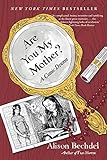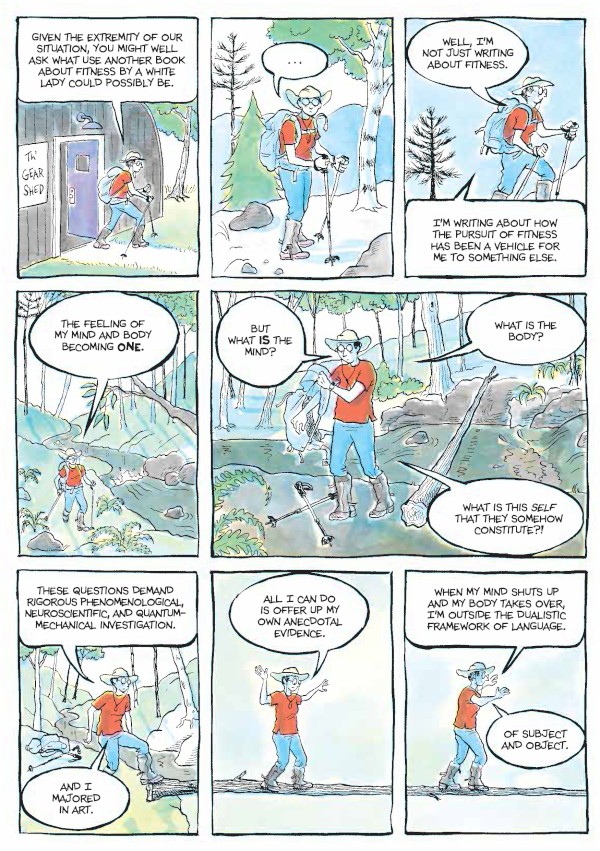Acclaimed cartoonist Alison Bechdel shifts gears and takes center stage in her new graphic memoir, The Secret to Superhuman Strength, out now from Houghton Mifflin Harcourt. While her previous memoirs focused on her parents, in this new book, Bechdel uses physical exercise as the lens through which she looks back on her life.
Bechdel’s bestselling, critically acclaimed 2007 graphic novel Fun Home was her memoir of growing up with her father, a closeted gay man whose frustrations and obsessions affected the whole family. Next came Are You My Mother? (2013), in which Bechdel revisits her relationship with her mother.
In The Secret to Superhuman Strength, Bechdel tells her life story once again, this time focusing on her lifelong search for transcendence in tandem with a compulsive need for physical exercise. “It feels so good emotionally and psychically to get to that state where I am not trapped in my stupid annoying self,” she say, “but I am in that flow state where my self is blessedly silent and I’m just part of something bigger.”
It’s a feeling that often comes with exercise as well as a lot of high-tech gear and stylish workout apparel that Bechdel lampoons along with her own need to buy the stuff. So Bechdel tells her story through her need for exertion in an account that includes wisecracking social satire and deep literary reflection. Decade by decade, she depicts herself skiing, running, biking, training in martial arts, and doing yoga, incrementally gaining illuminating experiences and self-knowledge with each one.
As in her other graphic novels, Bechdel weaves in canonical literary works by writers whose lives resonate with hers. “In all of my books, those other writers and thinkers come in in a really organic way, just as I am struggling to figure out what I want to say,” she says. This time, she started with Jack Kerouac’s novel The Dharma Bums. “The thing I loved is the way he went out in the back country and hiked in the Cascades and the Sierras with Gary Snyder back in the 1950s, when that was something that people in general didn’t do that much,” she says. “I found it very compelling; I like hiking and being outdoors. And while they were doing those things, they were talking about Zen and all these ideas about Buddhism and the nature of reality, which I also found very compelling. Somehow those things all connected.”
So she set out to learn more about Kerouac and then moved on to one of his chief influences, Ralph Waldo Emerson and the Transcendentalists. “They were the original hippies,” she says. “These people in the early- to mid-19th century were forming communes and going vegan and sending kids to progressive schools and they had radical race and gender politics. I could completely identify with them. They were like my friends.”
That in turn led her to the English Romantic poets William Wordsworth and Samuel Taylor Coleridge. “I’m not a big poetry person, really,” she says, “but I became really interested in their lives and the way they too wrote about nature, having these sort of ecstatic experiences in nature that the Transcendentalists were so moved by. I felt like I was somehow connected to this lineage of writers.”
Of course, Bechdel is more than a writer: She is a cartoonist, and combines art and text to create a story that is bigger than both. “I work hard to make my panels something that you have to read in the same way that you read words,” she says. “The image has to really play off of the text, show information that’s not in the text. It has to be something complicated. Something that will take you time and reward you for reading.”
Bechdel has been drawing comics for more than 40 years, starting with Dykes to Watch Out For, a pioneering comics strip depicting a very funny community of lesbian characters which ran from 1983 to 2008, and with each of her subsequent graphic memoirs she pushes herself and her work further. The Secret to Superhuman Strength is the first book to be in full color, a decision she made early on.
“I always feel I have to up my game with every book,” she says. “When I first became a cartoonist, it was before color was economically feasible, so I just did black and white. I loved black and white. I used a lot of crosshatching to get tonalities and gradations. With color you use color to do those things. It was a challenge that I set for myself. It also felt important to make this book, that is so much about life and vitality and exuberance, in color. It just seemed like a natural thing to do.”
Bechdel also breaks the fourth wall in the introduction to Superhuman Strength, speaking directly to the reader as she works her way through a variety of exercise activities, from running to skiing to yoga.
Another departure from her earlier work is the way her story unfolds on the page. In Fun Home, she stuck to the classic six-panel grid, but in Superhuman Strength, she varies her page compositions, moving between traditional panels and full-page images and two-page spreads done in a soft gray ink wash unlike the style anywhere else in the book.
“The moments I do in this gray ink wash are moments of transformation,” Bechdel says, “or these moments that have stood out for me in my life where I had a realization of some kind. To me, they show this other register of reality, as opposed to the regular panels, which are done with black ink outlines. There are no lines in the ink wash. It’s all blurry, tones that kind of feel like this other level of reality where things aren’t all separate and defined the way they are in our everyday daily life.”
This is the essence of what Bechdel is looking for throughout the book. She finds these moments of transformation not only in biking, skiing, hiking, but also in drawing comics, when she throws herself into her work and everything else falls away. Fittingly, she finds it once more in the creation of the book itself.
That wasn’t something she had anticipated. “It’s weird because it all started to come together a year ago, just when the pandemic started,” she says. “The deadline was crushing down on me. I had been drawing but not nearly fast enough to get the book done in the allotted time, so I had to go into this magical hyperdrive. Being in lockdown was the absolutely perfect state. I couldn’t go anywhere or do anything anyhow, so I had this wonderful experience of month after month of drawing.”
In Fun Home, Bechdel depicts her relationship with her father, and in Are You My Mother?, she writes about her mother. In its more singular focus on Bechdel, The Secret to Superhuman Strength feels a bit like the culmination of a trilogy.
“I have been trying to put the three books in relation, and they do seem to be a kind of trilogy,” she says. “Our fathers are like the first separate person that we encounter, so that first book was a way of negotiating that farther-out relationship, then with Are You My Mother? it became more internal; as opposed to the sort of oedipal world of the father it became this pre-oedipal world of what happens before we learn to speak in those early days with the mother, or whoever your main caretaker is in the family. In this new book, I feel like I’m getting down even deeper to what is the nature of the self, in a less psychological and more philosophical way. Is there even really such a thing as the self?”
Bechdel’s is reluctant to talk about her next project but says it will probably be less chronological than the three memoirs. “I think I would look more at particular themes,” she says, “and I think that’s an endless mine of possibilities.”
That means stepping away from the drawing board from time to time. “That’s the thing about being a memoirist,” she says. “You have to stop doing the work and go do something so you can write about it.”
Bonus Links:
—A Little in Love with Everyone: On Alison Bechdel
—Always This Mystery: The Millions Interviews Alison Bechdel
This piece was produced in partnership with Publishers Weekly.
















